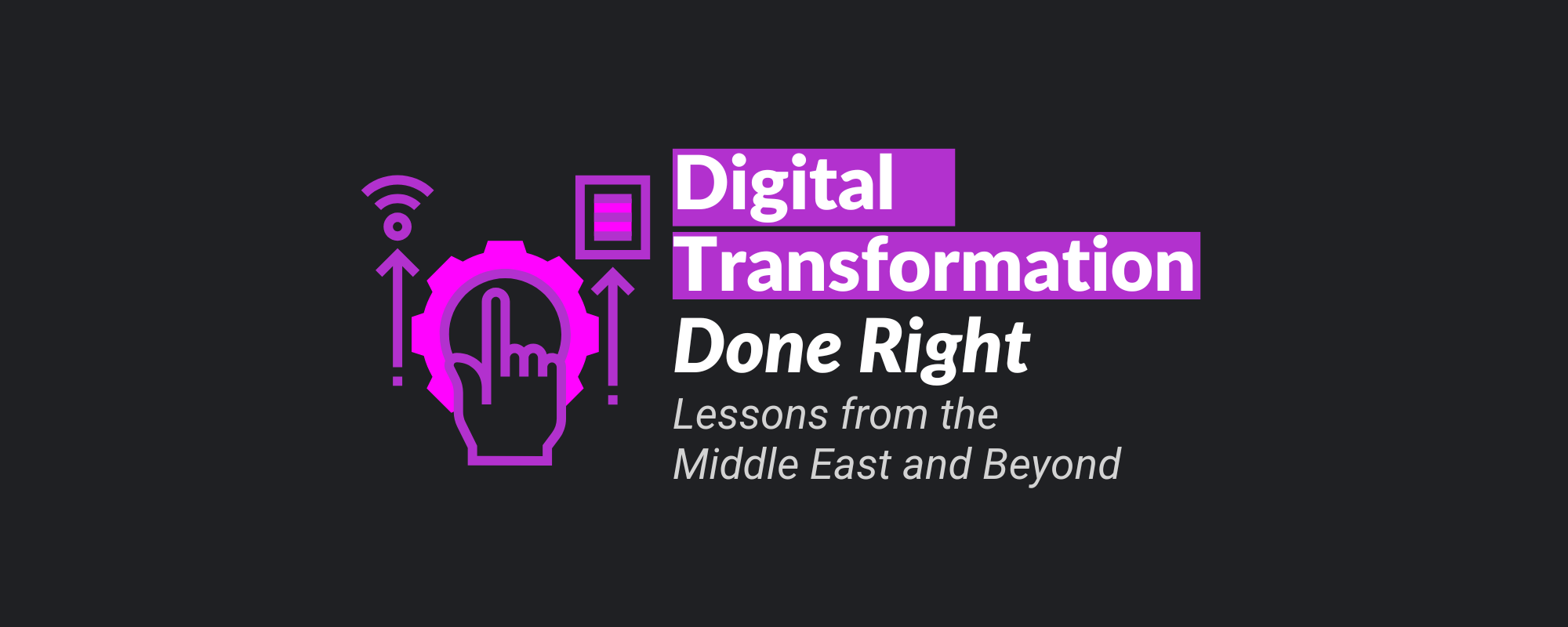Digital Transformation Done Right

Digital transformation -sigh- it's a phrase that has dominated boardrooms, sparking endless debates and ambitious plans. But let me ask you this: what does it truly mean for a business? Is it just another trend, or could it be the key to staying relevant in an ever-changing world? It sounds modern, flashy, essential—but for many traditional industries, it’s a daunting prospect cloaked in buzzwords and fancy gadgets. What does it truly mean, beyond installing a new CRM system or rolling out an app?
Let’s strip away the jargon and get real. Digital transformation isn’t about slapping some tech on an old process. It's about a fundamental, almost radical, change in how businesses operate—how they think, how they act, how they deliver value. It’s about rethinking everything from the ground up to unlock potential that no one even knew was possible.
This is where it gets raw. Not every company will make it through. In fact, 70% of digital transformation projects fail[1]. That’s a sobering number. The hard truth is that, often, it’s not about the technology failing—it’s about people failing to adapt, failing to connect the dots, failing to lead the change.
And yet, there are those that get it right. They do more than digitize; they transform. These are the stories worth telling, the blueprints worth studying.
What Holds Traditional Industries Back?
Let’s face it—traditional industries like manufacturing, finance, and logistics are built on decades, sometimes centuries, of conventional wisdom. And while that wisdom has served them well, it has also become their greatest obstacle. Consider Honeywell: once a simple thermostat manufacturer, they transformed into a data-driven powerhouse by embracing IoT. This kind of shift isn’t easy, but it’s necessary to thrive. That wisdom has served them well, but it can also be their greatest obstacle. The old ways might have worked for decades, but in today's world, sticking to 'tried and true' methods often means getting left behind. The factory manager with his battle-tested methods might not see the point of AI, but those who adapt are the ones thriving.
But the truth is, that mindset is precisely what holds these industries back. Legacy systems—both in the technology and in the way people think—become roadblocks. Bureaucratic hierarchies stifle innovation. Talent capable of driving digital initiatives is scarce, and, perhaps worst of all, there’s a risk aversion that’s built right into the DNA of these organizations.
No one wants to be the first penguin off the ice, especially when there are profits on the line. But in today's world, not changing is the biggest risk of all.
Those Who Dared
Honeywell: Manufacturing Reinvented
As mentioned earlier, Honeywell was founded over a century ago as a thermostat manufacturer. They could have been a relic of the past—a dinosaur—but instead, they chose to evolve. Honeywell embraced the Internet of Things (IoT), connecting their machinery for smarter, data-driven production. They didn’t just stick a sensor on a machine and call it a day; they redefined efficiency by leveraging real-time insights to drive decisions, prevent breakdowns, and ultimately save millions.
This wasn’t about the tech. It was about what the tech enabled—the shift from reactive to proactive, from fragmented to integrated. That’s transformation.
Emirates NBD: Banking on Digital
Closer to home, look at Emirates NBD. A traditional bank rooted in UAE’s landscape, it decided to lead, not follow, when it came to digital. Their customer-centric app is intuitive, agile, and continuously evolving—putting customer convenience at the center of every decision.
They embraced robotic process automation to streamline repetitive tasks, freeing up human talent for work that actually matters. This wasn’t just about getting an app out there; it was about rethinking how banking is experienced, every step of the way.
Aramco: Tradition Meets Innovation in Oil & Gas
And then there’s Aramco, the Saudi giant of oil and gas. The very definition of a traditional industry. If anyone could stick to their ways, it would be them. But they didn’t. They’ve pioneered the use of digital twins—virtual replicas of physical assets—that enable predictive maintenance. By understanding when equipment is likely to fail before it actually does, they keep the operation efficient and prevent costly downtime.
This is how tradition and innovation can co-exist. When you see a company like Aramco embrace digital transformation, you start to realize that no industry is beyond reach. It’s just a matter of leadership.
Healthcare’s Leap Forward
In healthcare, the transformation has been nothing short of revolutionary (yes, I’m using the word, but bear with me—it’s true this time). The COVID-19 pandemic pushed the healthcare sector to move faster. Telemedicine became mainstream, not because it was shiny and new, but because it was necessary. Digital health records became more interconnected, more useful, more alive.
Wearable technology and AI are now driving better diagnoses, personalized care, and a more proactive approach to wellness. The barriers of entry for healthcare tech were high—bureaucracy, privacy concerns, legacy systems. But necessity proved to be the ultimate catalyst.
The Energy Sector: Sustainability Through Smart Grids
The energy sector has been similarly impressive. Integrating IoT and AI, many energy companies are creating smart grids that don’t just supply energy, but actively manage it to reduce waste and promote sustainability.
This isn’t merely about "keeping the lights on." It’s about making energy smarter—using data to match supply with demand, making cities greener, reducing carbon footprints, and making efficiency a core principle. It’s hard to call that anything other than transformational.
In the Middle East, the Dubai Electricity and Water Authority (DEWA) exemplifies this transformation. DEWA has implemented a comprehensive Smart Grid Strategy aimed at enhancing efficiency and sustainability in energy distribution. This strategy includes the deployment of over two million smart meters, automation of transmission networks, and the integration of renewable energy sources. By leveraging advanced technologies, DEWA not only ensures reliable energy supply but also promotes environmental sustainability and operational excellence[4]. This is not just about embracing new technology; it’s about reshaping the entire landscape of energy management in Dubai.
Elements of a Successful Transformation
Digital transformation is not a paint-by-numbers exercise. It’s more like a dynamic puzzle—where each piece shifts, adapts, and requires a careful understanding of how everything interconnects. Those who succeed are the ones who understand that it’s not just about the tools, it’s about the culture, the approach, and the willingness to change.
It Starts With Mindset
It’s easy to buy technology; it’s much harder to foster a culture of innovation. True transformation starts with people—getting your team to embrace new ideas, rewarding experimentation, not punishing failures. It’s about creating a culture where the phrase “this is how we’ve always done it” is met with skepticism, not comfort.
Vijay Jaswal, CTO at IFS, said it best: “With the UAE’s Vision 2031 and Saudi Arabia’s Vision 2030, the push for digital transformation is stronger than ever, and companies are leveraging key technologies to accelerate this shift”[5]. But leveraging technology without a cultural shift is like trying to run a marathon in a three-piece suit—sure, you can technically do it, but you won’t get very far.
Agility Wins
The old rulebooks don’t work anymore. For many traditional industries, operating on annual plans and rigid structures won’t cut it. Agility isn’t just a buzzword—it’s the ability to sense opportunities and pivot quickly. Karthik Anandarao puts it into perspective: “More and more organizations are moving away from traditional on-prem IT solutions and adopting cloud-based models. This shift is allowing businesses to be more agile and responsive to market demands, and AI and ML are playing a critical role in this transition”[6].
The cloud is not just storage; it’s flexibility, it’s scale, it’s about enabling ideas to take shape without the old constraints.
Partnerships: Because No One Can Do It Alone
Successful digital transformations are rarely an isolated effort. Smart companies look outward—they collaborate with startups, with governments, with tech giants. They know that expertise is often found elsewhere, and there’s no shame in tapping into that.
The governments of UAE and Saudi Arabia have been pivotal in setting the stage. Vision 2031 and Vision 2030, respectively, have provided the framework for public-private partnerships, opening doors for traditional industries to access technologies that can transform their operations. That’s the kind of collaboration that’s changing the game.
The Middle East: A Fertile Ground for Transformation
The Middle East is emerging as an unexpected but potent hub for digital transformation. Government visions, smart city initiatives, and investments in technology are creating an environment where change isn’t just welcome—it’s expected.
Saudi Arabia and UAE aren’t just dipping their toes in the waters of digital transformation—they’re diving in headfirst. The Middle East digital economy is expected to contribute $230 billion by 2025[3]. That’s not a trivial number, and it speaks volumes about the direction this region is taking.
Digital transformation isn’t just about the shiny things, it’s about economic diversification, about sustainability, and about creating jobs in sectors that simply didn’t exist before. The Middle East has proven that it’s ready for that challenge.
The Raw Truth: Where Do We Go From Here?
If you’re an executive in a traditional industry, I’m not here to offer you another generic consulting solution. I’m here to tell you that the cost of inaction is greater than the risk of failure. Your people need to feel empowered to experiment. Your processes need to be torn down and rebuilt. And your mindset? Well, it needs to evolve.
Cybersecurity will be a challenge—no doubt. Unequal access to technology will persist. But the opportunities are there. The Middle East’s ambitions, its government initiatives, and the increasing tech-savviness of its youth are all converging to make this the perfect moment to embrace digital transformation.
What will define success is not just the technology, but the human spirit that drives it—curiosity, resilience, and the ability to dream beyond the obvious. Digital transformation isn’t an end point; it’s a continuous journey, one that gets richer with each step.
The only real question is, are you ready to take that step?
[1] McKinsey, "70% of digital transformation projects fail, often because organizations ignore the people element." McKinsey.
[2] World Economic Forum, "By 2025, digital transformation could unlock up to $100 trillion in value for both industry and society." World Economic Forum.
[3] IDC, "The Middle East and Africa’s digital economy is expected to contribute $230 billion by 2025, with traditional sectors being significant contributors." IDC.
[4] Dubai Electricity and Water Authority (DEWA), "DEWA has implemented a comprehensive Smart Grid Strategy aimed at enhancing efficiency and sustainability in energy distribution." DEWA.
[5] Vijay Jaswal, CTO at IFS, "With the UAE’s Vision 2031 and Saudi Arabia’s Vision 2030, the push for digital transformation is stronger than ever, and companies are leveraging key technologies to accelerate this shift." Allied Market Research.
[6] Karthik Anandarao, Chief Technical Evangelist at ManageEngine, "More and more organizations are moving away from traditional on-prem IT solutions and adopting cloud-based models. This shift is allowing businesses to be more agile and responsive to market demands, and AI and ML are playing a critical role in this transition." Mordor Intelligence.



Discussion